Youngstock are the future of the cattle herd. Early-life calf management has far-reaching consequences for health, welfare, and the profitability of the ruminant livestock business (Boulton et al, 2015).
Over 3 million calves are born in the UK every year (Defra, 2020), but many fail to reach adulthood due to disease; for example the mortality rate in dairy calves under 3 months of age has been shown to be between 2.4–11.7% (Johnson et al, 2011).
Youngstock disease has been identified by the Responsible Use of Medicines in Agriculture (RUMA) Targets Taskforce (RUMA, 2017) as an area for reducing antibiotic use. Bovine respiratory disease (BRD) and calf diarrhoea are the most common causes of calf morbidity and mortality (Wathes et al, 2008), and were identified by RUMA as the two major disease areas for industry focus. It is important to learn more about how farmers manage these diseases, and identify where improvements can be made, to put these recommendations into practice.
Recently in the UK, efforts have been made to engage veterinary surgeons in cattle youngstock disease and management, as shown by the addition of a specific ‘youngstock stream’ at the yearly British Cattle Veterinary Association (BCVA) Congress and the in-creasing interest in youngstock services at veterinary practice level (author's observations). Engaging the farmer in this area remains challenging (Bard et al, 2017); the farmer may receive information from a variety of sources other than the veterinary practice, or in-formation may not be targeting the designated calf caregiver.
In the UK, the cost of infectious respiratory diseases in young calves has been estimated to be between £30 and £500 per affected calf (Andrews, 2000; ADAS, 2013a; Statham, 2013; Atkinson, 2016; Scott, 2017). Calves with BRD were shown to have a 30 day in-crease in time to first calving and reduction of bodyweight at 14 months of 29 kg (Brickell et al, 2009). BRD affects milk production and survivability; dairy heifers that suffered from BRD as a calf had an average reduction in first lactation milk production of 525 kg (Dunn et al, 2017), and heifers that experienced four or more BRD cases before first calving were significantly less likely to complete their first lactation than those that never displayed signs of BRD (Bach, 2011).
In beef calves, BRD has been shown to affect productivity. Cattle with lung damage were on average 21 kg lighter (Wittum et al, 1996) than healthy counterparts and even low levels of lung damage resulted in poorer carcass quality (Williams and Green, 2007).
The cost of enteric disease (reduced growth rates, mortality and treatment) to the national cattle herd was estimated at £11 million in 2003 (Bennett and Ljpelaar, 2005). Cattle that suffered from diarrhoea had increased susceptibility to other disease (Heinrichs and Heinrichs, 2010), and dairy heifers were 2.5 times more likely to be sold (Waltner-Toews et al, 1986). The average cost of scour per affected suckler calf has been calculated as £193.13 based on a 100-cow herd, with 90 calves reared per 100 cows and 30 calves from the group treated (ADAS, 2013b).
The objective of this survey was to obtain recent data on farmers' attitudes and approaches to calf rearing and disease in the UK. Discovering how they typically manage diarrhoea and BRD aims to help veterinary surgeons better understand barriers to preventative management and identify areas for future improvements.
Materials and methods
The survey was undertaken during May 2018, was open to any UK farmer with online access who owned cattle and was promoted via Facebook and Twitter online social media platforms. Paid targeted online advertising was used to increase survey reach. The survey consisted of 30 questions (Table 1) covering many aspects of calf rearing in health and disease, particularly focusing on diarrhoea and BRD, methods of diagnosis, treatment and prevention of these diseases. Farmers' attitudes were also assessed. The questions were predominantly multiple choice; however more than one answer could be selected for some questions. Data were collected automatically and anonymously by the online survey provider, then analysed in-house. Personal information such as geographical location of the farm, age of the farmer, etc. was not collected. Ethics approval was not required for this anonymous cross-sectional survey.
Table 1. Questions and response options in the youngstock survey* In all cases, only one option could be selected unless stated otherwise
| 1. What primary type of enterprise do you have? | Dairy, Beef, Calf rearer |
| 2. How many of the following do you have? | Dairy cows, beef cows, calves reared annually |
| 3. Who looks after the youngstock on your unit? | Farmer, farmer family member, employee, no individual's role/responsibility, other |
| 4. How much time does youngstock management take up on the farm? | <20%, 20–40%, 40–60%, 60–80%, >80% |
| 5. How happy are you with your youngstock rearing processes? | Scale 1–10, 1 being completely unsatisfied and 10 completely satisfied |
| 6. What is the average daily liveweight gain for your youngstock? | Unknown, <0.5 kg/d, 0.6 kg/d, 0.7 kg/d, 0.8 kg/d, 0.9 kg/d or above |
| 7. What is the age of first calving for the heifers you rear? | <24 m, 24 m, 25 m, 26 m, 27 m, >27 m, we don't rear replacements |
| 8. Do you feel the youngstock get enough attention? | Yes, No |
| 9. What is the one area you would like to improve or are concerned about when thinking about youngstock production? | Free text answer |
| 10. How much colostrum do you feed newborn calves in the first 24 hours of life? | >6 l, 3–6 l, 1–3 l, calves suck from the cow |
| 11. When feeding colostrum, do you check its quality first? (with a colostrometer or Brix refractometer?) | Always, sometimes, never |
| 12. How long do you feed colostrum to your calves? | 24 hours, 1–3 d, over 3 d, suckle from dam, buy in calves from 1 w of age |
| 13. If you rear dairy calves, what do you use as colostrum? | Dams colostrum only, first milking only, first day's milk, first 2–4 d milk, pooled colostrum, waste milk, don't rear dairy calves |
| 14. How often do you test transfer of antibodies from colostrum to calf by analysis of blood samples? | >4x/y, 1–4x/y, only when I have a problem, never |
| 15. Do you vaccinate dams to boost colostrum? | Yes, whole herd. Yes, only select cows and heifers. Yes, but only a few dams to pool colostrum. No |
| 16. In the last year, what proportion of your calves under 6 months have experienced scour problems? | 0%, 1–10%, 11–30%, 30–50%, >51% |
| 17. In the last year, how many calf deaths have you experienced as a result of scour (as a % of calves reared) | 0%, 1–5%, 6–10%, 11–25%, >25% |
| 18. What age of calves are most affected by scour on your farm? | Not affected, 1–7 d, 8–21 d, >22 d |
| 19. If you have had a definitive diagnosis of the cause of scour problems on your farm, what organism was isolated? (multiple options could be selected) | Rotavirus, coronavirus, cryptosporidium, salmonella, didn't diagnose, other |
| 20. How do you treat scouring calves? (select all that apply) | Antibiotics, electrolytes, halofuginone, a combination of above, other |
| 21. At what stage do you call your vet during a scour outbreak? | At first sign of scour, when 10% of calves have got scour, after >10% of calves have got scour, if a calf dies, never |
| 22. How do you prevent infectious scours gaining a foothold on your unit? (select all that apply) | Good hygiene, use of dam vaccination, scour pastes, good colostrum feeding practices, use of halofuginone, other |
| 23. In the past year, what proportion of your calves under 6 months have been affected by bovine respiratory disease (BRD)? | 0%, 1–10%, 11–30%, 31–50%, >51% |
| 24. In the last 12 months, what proportion of calf deaths have you experienced as a result of BRD (expressed as a % of calves reared) | 0%, 1–5%, 6–10%, 11–25%, >25% |
| 25. What age of calves are most affected by BRD on your farm? | 0–10 d, 10 d–6 w, 6 w–6 m, >6 m |
| 26. Which pathogens were identified as the cause of BRD on your farm? (select all that apply) | Mannheimia haemolytica, Mycoplasma bovis, husk/lungworm, BRSV, PI-3, IBR, Trueperella pyogenes, Pasteurella multocida, Histophilus somni, didn't diagnose |
| 27. How do you treat calves with BRD on your farm? (select all that apply) | Antibiotics, anti-inflammatories, intranasal vaccine, isolate from group, combination of above |
| 28. At what stage do you call your vet during a BRD outbreak? | At first signs of pneumonia, after 10% of calves show signs of pneumonia, after >10% of calves show signs of pneumonia, when a calf dies, never |
| 29. How do you prevent BRD gaining a foothold on your unit? (select all that apply) | Good hygiene, use of vaccination, good colostrum management, improving building ventilation, isolation of new animals |
| 30. Do you change vaccine regimen depending on what pathogens are diagnosed on your farm? | Yes, no, I don't diagnose the pathogen |
Results
The survey was started by 749 farmers and completed by 479. Only answers from farmers that completed the survey were analysed. Between them, these farmers managed 171 257 head of cattle which comprised 255 beef units, 174 dairy units and 50 calf rearing units. Overall, these farms represented 1.7% of total UK cattle in 2017. The national UK herd comprised 9.7 million cattle in 2017; of which 28% were beef, 28% were dairy (not including beef/dairy cattle <1 year) and 24% male youngstock 0–2 years (calculated from DEFRA, 2017 figures).
The average size of a dairy herd in this study was 335, which is larger than the 2017 national average of 146 (AHDB, 2020), however, there were two very large dairy herds of 1500–2000 cattle in this study which raised the average.
Completed questionnaires were received from farmers managing beef herds of between 1 and 2000 cattle, reflecting the overall UK situation. The average herd size was 140 in this study.
The average size of a calf-rearing enterprise in this study was 479 calves, however this result was skewed by one enterprise rearing 10 000 calves. When this unit was removed from the calculation, the average size was 285 calves per unit.
General attitudes
On average, farmers rated their youngstock rearing practices 7.7 out of 10. However, a notable proportion felt that youngstock did not get enough attention (dairy 45%; beef 34%; calf rearer 30%). For the largest proportion of farmers (37%), youngstock rearing took up 20–40% of their working time. For dairy farms, only 34% of farmers stated it was they who cared for the youngstock; on 60% of units, the primary youngstock carer was a family member or employee. This contrasted with the beef and calf rearing enterprises where the farmer was the primary youngstock carer in 50% and 48% of responses respectively. Only 7% of beef units relied on employees to care for the youngstock compared with 30% of dairy and 14% of calf rearers.
Goals and measures
Housing, stocking density and facilities were the top areas for desired improvement, with 21% of farmers providing this answer in a free-text question. Ventilation was identified by 6% of farmers as an area they wanted to improve (Table 2). Only 6% and 4% of farmers stated that they wanted to improve disease levels (BRD and diarrhoea respectively).
Table 2. Areas respondents wanted to improve most on their farm (free text answer)
| Areas respondents wanted to improve most on their farm (free text answer) | % of farmers |
|---|---|
| Housing, stocking density & facilities | 21 |
| Monitoring and achieving appropriate DLWG | 13 |
| Inadequate biosecurity and disease prevention | 11 |
| Inadequate weaning and transition management | 8 |
| Age at first calving, calving ease and fertility | 6 |
| Inadequate colostrum management | 6 |
| Pneumonia/bovine respiratory disease | 6 |
| Inadequate ventilation | 6 |
| Inadequate nutrition, mineral and feed management | 6 |
| Scour/diarrhoea | 4 |
DLWG-daily liveweight gain
A productive animal should calve at or before 24 months of age (Hewitt, 2019), and many units claimed to be calving down at 24 months on average, with 33% of dairy and 28% of beef farmers providing this answer. However, 41% of dairy farmers and 47% of beef farmers indicated that their heifers were calving down at over 24 months of age. A further 18% of beef farmers stated that their heifers were calving down at over 27 months of age.
The Agriculture and Horticulture Advisory Board (AHDB) recommended daily liveweight gain (DLWG) in order for a dairy heifer to calve down by 24 months is 0.8 kg/day and to finish a beef calf is 0.8 kg/day up to weaning and >1 kg/day post weaning, however our survey demonstrated that many farms were not measuring or achieving this. DLWG was not measured by 46% of farmers surveyed (dairy 42%; beef 50%; calf rearer 37%) and 27% of all farmers stated their youngstock DLWG was 0.7 kg/day or less. Calf rearers seemed to be more focused on this area, with 24% stating they achieved DLWG of 0.9 kg/day or higher. The timeframe throughout which these DLWGs were achieved was not asked in the question.
Colostrum management
There was a wide variation between beef and dairy farmers in their colostrum feeding management, assumedly because of their different systems.
Dairy farmers were more involved in colostrum management:
- Duration — 70% of dairy farmers fed colostrum for more than 24 hours with 26% feeding it for more than 3 days
- Quality — 27% of dairy farmers always checked this. 50% of dairy farmers only used the dam's colostrum, whereas 19% used pooled colostrum
- Quantity — 54% of dairy farmers gave calves over 3 litres of colostrum in the first 24 hours, 19% of dairy farmers gave calves 1–3 litres of colostrum only and 27% of dairy farmers left calves to suckle the dam without providing any colostrum at all
- Quantify — testing calves for successful passive transfer of immunoglobulins from colostrum via blood test was never performed in 53% of dairy farmers surveyed, and 28% only tested in the event of a problem.
Beef calves were managed less intensively:
- Duration — 83% of beef farmers surveyed left calves to receive colostrum by suckling the dam without intervention
- Quality — only 9% always checked colostrum quality
- Quantify — beef farmers were even less likely to test passive transfer with 83% of beef farmers indicating they never tested calves and a further 14% only testing when there was a problem.
Dam vaccination against scour pathogens is a recognised method of boosting colostrum quality and helps to protect calves against infectious causes of diarrhoea. However, 71% of farmers did not utilise dam vaccination, despite there being high levels of morbidity and mortality from this disease in calves managed by the farmers surveyed.
Perception of presence and impact of disease
Calf diarrhoea
Morbidity and mortality in calves under 6 months of age as a result of diarrhoea were commonly observed by farmers in this survey. Diarrhoea was experienced by 82% of farmers in their calves in the last 12 months, (dairy 93%, calf rearer 89%, beef 72%). On average, 48% of farmers had deaths in calves as a result of diarrhoea (highest in dairy at 68%), and only 18% had not experienced any diarrhoea on their farms (Figure 1).
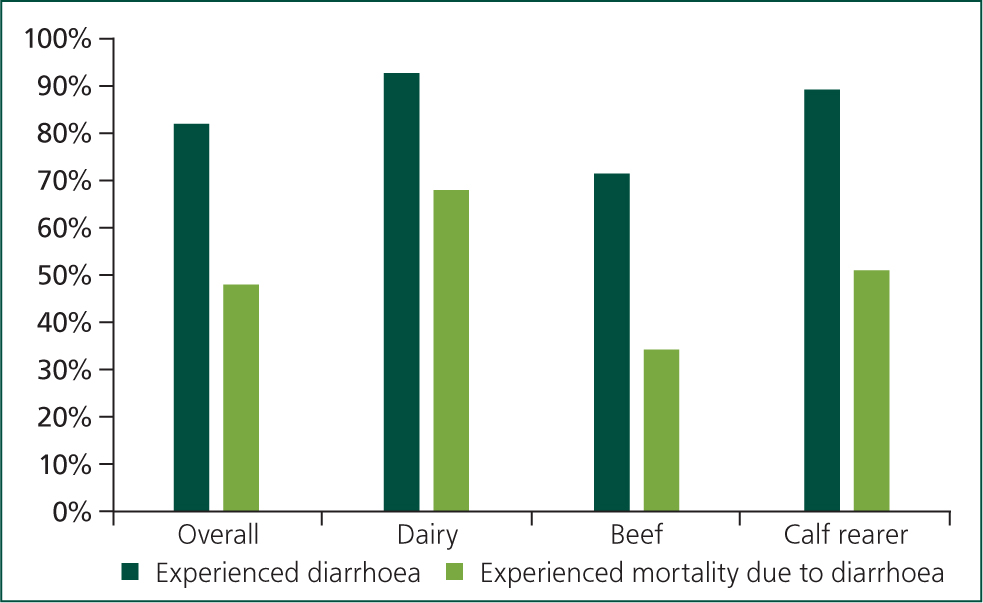
Calves aged 8–21 days were most affected by diarrhoea (40% of farmers reported diarrhoea in these calves), however 32% of farmers indicated that diarrhoea presented within the first week of life.
Diagnosis was underutilised, with 49% of farmers surveyed not diagnosing the cause of diarrhoea in their calves. Dairy farmers were more likely to use diagnostics (66% compared with 41% and 43% for beef and calf rearers respectively). Rotavirus and cryptosporidium were the most commonly diagnosed pathogens on all farms but were found most often on dairy farms (rotavirus 17%; cryptosporidium 23%) compared with beef (rotavirus 8%; cryptosporidium 12%) and calf rearer (rotavirus 8%; cryptosporidium 11%) (Figure 2).
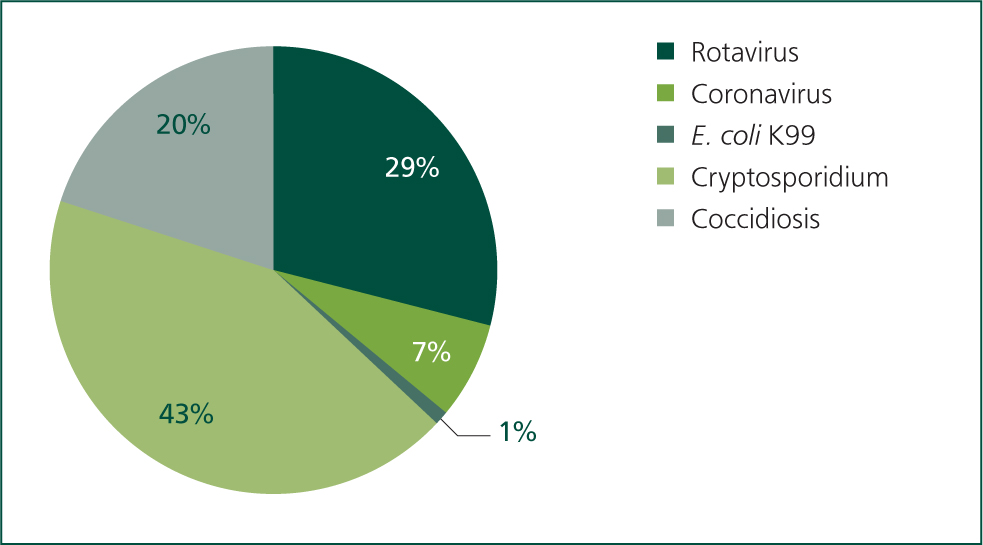
Bovine respiratory disease
Morbidity and mortality as a result of BRD in calves under 6 months of age was also experienced commonly by farmers in the previous 12 months (Figure 3). The dairy and calf rearing units were particularly affected as only 20% of dairy farmers and 24% of calf rearers had not experienced BRD, whereas 43% of beef farmers stated they had not had any BRD in young calves.
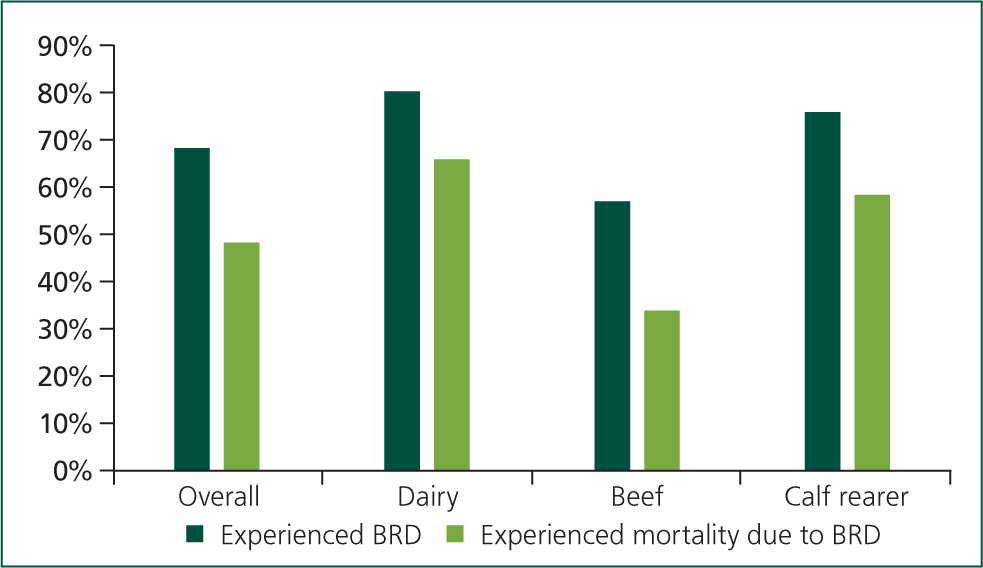
Beef farmers were most likely to call the veterinary surgeon out at the first sign of BRD (44% vs 25% dairy and 26% calf rearer), which could reflect the higher individual value of beef youngstock. However, 12% of all farmers would never call the veterinary surgeon out for BRD, even after mortality (Figure 4).
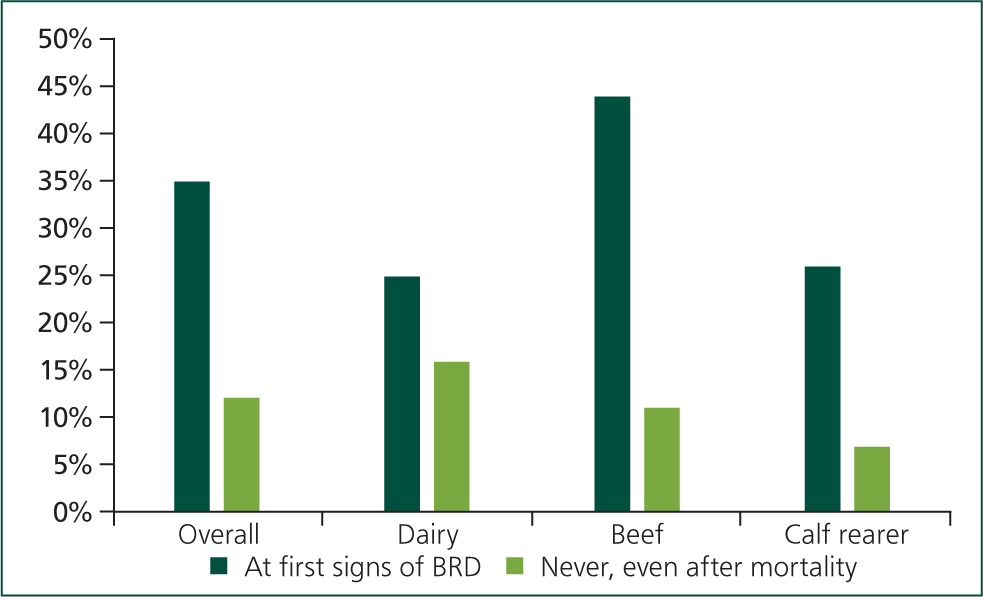
Farmers indicated that calves 10 days–6 weeks old were the most affected by BRD as 41% of farmers had seen the disease in this age group in the last 12 months. Interestingly, 37% of calf rearers experienced BRD outbreaks in older calves (6 weeks–6 months age range). This pattern was not mirrored by the beef or dairy units in this survey.
BRD aetiology was not diagnosed by 66% of farmers surveyed. Calf rearers were more likely to use diagnostics (47% compared with 40% and 27% for dairy and beef respectively). Bovine respiratory syncytial virus (BRSV) and Mycoplasma bovis were the most frequently diagnosed pathogens (Figure 5).
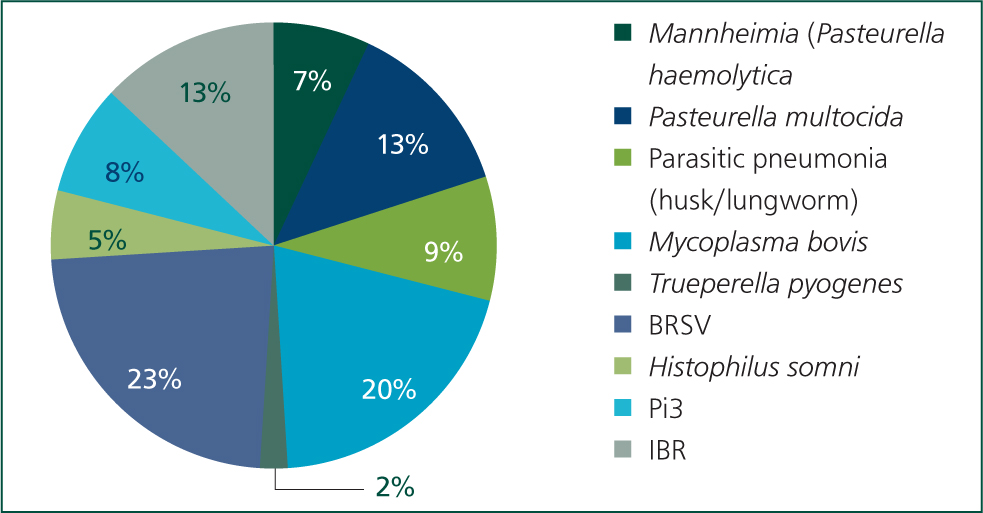
Management of disease
Calf diarrhoea
The veterinary surgeon was frequently not called out to treat diarrhoea on farm, even after mortality (Figure 6). Only 15% of dairy farmers, 25% of beef suckler farmers and 18% of calf rearers would call the veterinary surgeon at the first sign of diarrhoea and, overall, 20% of farmers surveyed would never call out the veterinary surgeon for diarrhoea, even after mortality.
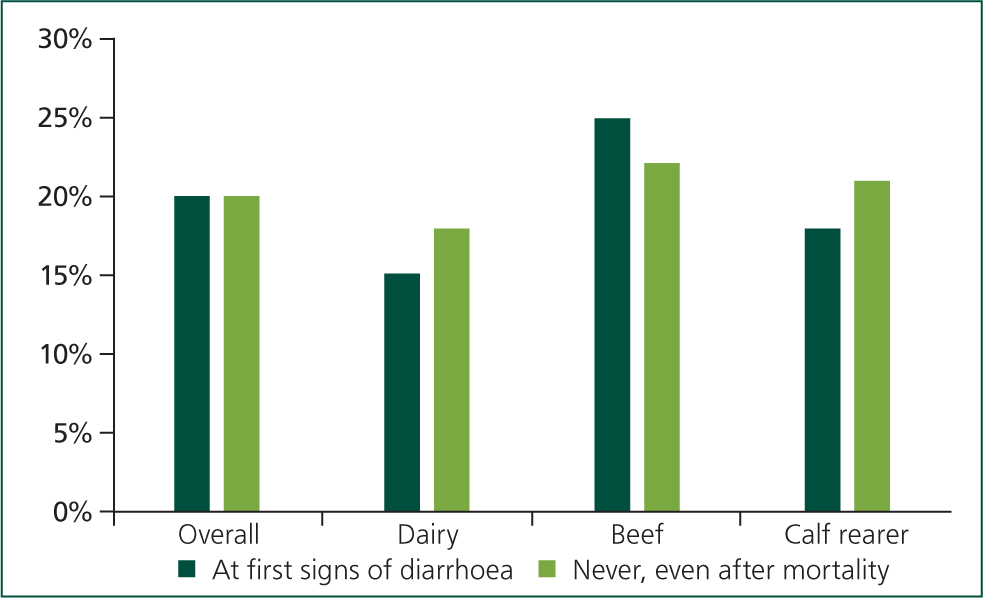
Electrolytes (used by 35% of all farmers) and antibiotics (used by 27% of all farmers) were the most frequently used treatments for diarrhoea (Figure 7).
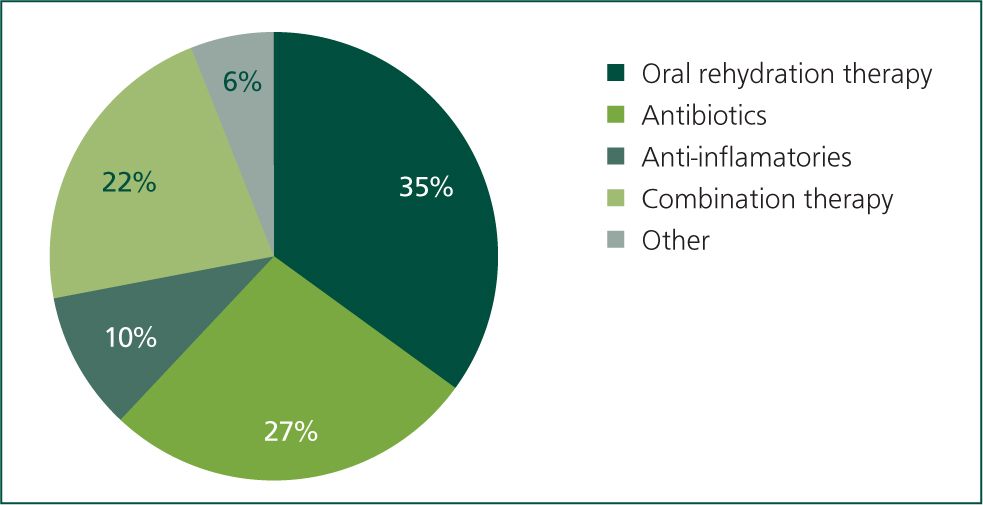
Good hygiene and colostrum management were seen as the key tools to prevent diarrhoea by farmers (50% and 26% of farmers respectively). The use of dam vaccination and ‘scour’ pastes were each selected by 9% of farmers.
Bovine respiratory disease
Antibiotics (36%) and anti-inflammatories (23%) were the most frequently used BRD treatments selected by respondents. Only 14% of farmers surveyed isolated the sick calf from the group (Figure 8).
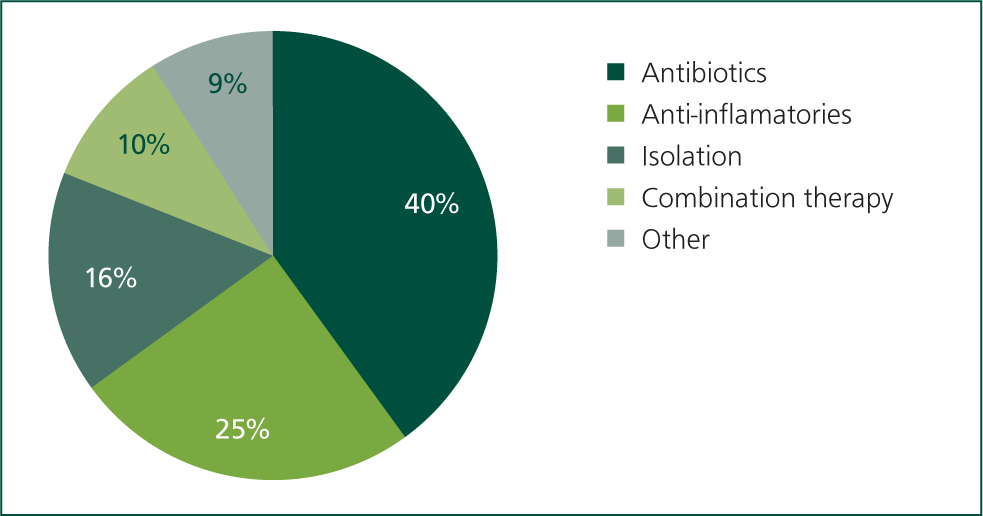
Good ventilation (28%) and hygiene management (27%) were most selected by farmers when asked how they prevented BRD. This contrasted with an earlier question where only 6% of farmers stated they wanted to improve ventilation. Colostrum management and vaccination scored lower with 18% and 15% of farmers selecting these choices respectively.
When asked if the results of diagnostic testing would prompt them to change vaccination regimen, only 30% of respondents said they would change vaccination depending on what pathogens were identified on the unit. Dairy farmers were more likely to change vaccine regimen than beef or calf rearers (Figure 8).
Discussion
Heifer rearing represents one fifth of a dairy farm's total cost (Tozer and Heinrichs, 2001), yet many areas of calf health were found to be neglected in this survey, on all three types of farm. Despite calf health and best rearing practices being in the spotlight in numerous agricultural publications and at industry events, understanding of the importance, and adoption of many of these practices was not uniform, or often achieved, among the sampled farmers.
This survey demonstrated a discordance between the farmer's satisfaction of their youngstock rearing processes, which was rated highly (average 7.7/10), feeling that the youngstock got enough of their attention (only 63% of farmers felt they did) and meeting industry objectives such as antibiotic use, age of first calving and levels of disease (which were frequently not measured or poor). For example, only 10% of farmers stated that they wanted to improve disease levels of BRD or diarrhoea, even though 82% of farmers had experienced diarrhoea and 68% of farmers had experienced BRD in the last 12 months. Does this mean farmers are satisfied even if they know the youngstock are not doing as well as they should be, or are they unaware that they are not meeting industry targets or taking recommended measurements? In a previous study it was found that benchmarking motivated farmers to improve calf management, focused their efforts and increased their confidence in their calf-rearing processes (Sumner et al, 2018). This technique could be utilised more on UK farms by veterinary surgeons to make farmers aware of industry targets and motivate them to meet these targets.
Adequate provision of high-quality colostrum is widely considered as one of the most important calf-rearing practices with a well-documented impact on health and performance (RUMA, 2019a). The importance of colostrum feeding was recognised by farmers in this study; however, colostrum feeding was more rigorously managed on dairy units. Our results for dairy farms showed 73% did not rely solely on natural suckling to ensure the calf got enough colostrum. This was in-line with a survey of Canadian dairy farmers, where it was found 82% of farmers implemented management practices to ensure the calf got colostrum in the first hours of life (Winder et al, 2018). However, there is still progress to be made in this area, as 46% of calves received 3 litres or less in the first 24 hours, which is well below AHDB recommendations of 6 litres in the first 12 hours.
Beef units were more reliant on natural suckling; likely due to increased difficulties in handling these animals and the more extensive UK beef suckler system. However, this means the farmer would be unaware of the volume of colostrum the calf receives in the first hours of life, which could lead to failure of passive transfer (FPT) (Corbishley, 2018).
There was infrequent or no monitoring of colostrum quality and passive transfer among all the surveyed farmers. A high proportion of FPT has been previously reported in UK beef calves at <50% (Corbishley, 2018), and dairy calves at 46.6% (Denholm and Haggarty, 2019), revealing an opportunity for veterinary surgeons to encourage farmers to optimise their colostrum management and include regular testing.
Diarrhoea and BRD accounted for a high incidence of disease and mortality on all types of farm in this study, reflecting findings of other UK studies (Johnson et al, 2017). Beef suckler farmers appeared to have a lower proportion of BRD cases, which could be as a result of less intensive/outdoor rearing practices and being kept with the dam to benefit from an extended period of suckling. Calf rearers experienced more BRD in older calves than beef suckler or dairy farmers. This again could be as a result of differences in rearing procedures, with reared calves undergoing more intensive or stressful processes. The RUMA Targets Taskforce identified BRD as one of the main reasons for antibiotic use on both beef and dairy units, and this studies' findings corroborate this; antibiotics were the primary treatment farmers used for BRD in their youngstock. In some cases, this may be appropriate as many of the causes of BRD are bacterial (Animal & Plant Health Agency (APHA) data), however this survey demonstrated that diagnostics were only used by 44% of farmers for BRD, so many could be treating viral BRD inappropriately with antibiotics.
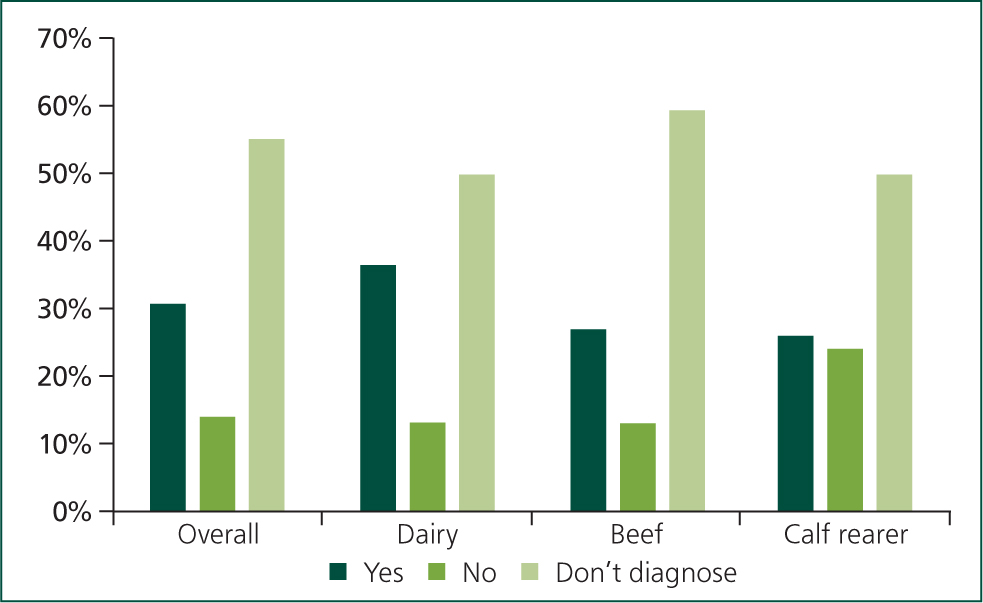
This survey also found that 27% of farmers were treating diarrhoea with antibiotics, however, unless the calf is systemically unwell, this is not recommended as most of the common causes of calf diarrhoea are not bacterial (APHA data).
According to the 2018 RUMA report (RUMA, 2019b), antibiotic use in the beef and dairy sectors has dropped significantly (21 mg/PCU in beef, 17 mg/PCU in dairy), although ongoing work is still needed to hit and maintain below the 2020 targets of 10 mg/PCU in beef and 21 mg/PCU in dairy.
Many farmers completing the survey did not use diagnostics or call the veterinary surgeon out for these diseases, even if they had experienced mortality. This suggests BRD and diarrhoea were seen as routine, and the losses accepted by these farmers. There is an opportunity for veterinary surgeons to have a more open discussion with their clients to help them understand that diagnosis, even if done at group level, allows for a more prudent choice of medicines, which will be specific for that farm and more likely to lead to a successful outcome.
‘Good hygiene’ and ‘improving ventilation’ scored most highly for all types of farm (27% and 28%) in the question asking how farmers prevented BRD. Isolation of new stock scored the lowest (12%), however this could be considered the most important aspect in preventing many diseases on farm. There is an opportunity here for veterinary surgeons to educate and promote the importance of biosecurity and particularly isolation of incoming stock.
Vaccination was generally underused for both diseases and not rated as being as effective as other preventative measures by farmers. Vaccination was perceived to be as equally efficacious as ‘scour’ pastes (which have no licensed claim for this use) at preventing diarrhoea. It appears that many farmers still see vaccination as an ‘intervention’ in situations where there is already disease and mortality; therefore, they do not see the true value of vaccination as a prophylactic.
Vaccination was identified by RUMA Targets Taskforce as a way of reducing antibiotic use along with hygiene, good colostrum management and protocols (RUMA, 2017). There is great potential to increase vaccine penetration on UK farms; a report by the AHDB calculated uptake of vaccination of breeding cows with enteritis vaccines was only 18% in 2017. However, BRD vaccine uptake in calves has risen from 29% in 2011 to 38% in 2017, showing an encouraging increasing trend (AHDB, 2020b).
This study also found that 14% of farmers were unwilling to change vaccination regimen depending on the results of on-farm diagnostics. This could be because of a fear of making problems worse or uncertainty using a new product. This is an area where veterinary surgeons could educate farmers; leading them through a diagnostic testing scheme, advising on the mechanisms of the disease, the role of the animals' immunity, and the choice of vaccine type and protocol to help them make informed decisions and ensure compliant vaccine use.
Limitations
The survey was accessed through social media platforms on Face-book and Twitter; therefore, some bias may have been introduced as only farmers with online access and those using these social media platforms could access the survey, and therefore it is likely that there is also a skewed response for farmer age; younger farmers being more likely to engage online. Additionally, farmers with a strong interest in youngstock health may have been more likely to complete the survey which could have favourably skewed the results.
Definitions of scour/diarrhoea and BRD/pneumonia were not given in the questionnaire; therefore, prevalence of these diseases could have been under- or over-reported if farmers were not sure of the symptoms. These diseases are frequently subclinical and under-reported (author's observations).
Other limitations included self-reporting by farmers — they may have wanted to appear to be performing better than they were (although the survey was anonymous), estimated values for morbidity and mortality may have been inaccurate as many farms do not keep good records (author's observations). Also, the person completing the questionnaire may not have been the person who actually cared for the calves.
The survey was started by 749 farmers and completed by 479, giving a drop-out rate of 36%, of which nearly 50% dropped out before question 2. There did not seem to be a particular question at which the remaining farmers dropped out, suggesting the survey was longer than anticipated or may not have been relevant to some farmers and their systems.
Significance of findings
The good response to this survey shows an interest from farmers in youngstock health. Farmers are knowledgeable about key factors such as colostrum management and housing. It highlights that there is potential to improve youngstock health and welfare on UK farms. There was a high reliance on antibiotics and often the veterinary surgeon was not involved in disease management decisions. Farmers were accepting of high levels of diarrhoea and BRD. Diagnostics and vaccination were underutilised.
The findings of this survey could further inform veterinary surgeons in understanding the farmers' point of view, as well as providing insights on how farmers approach disease in youngstock, to help veterinary surgeons focus on shared goals and place more effort in changing how farmers perceive their routine veterinary visit.
A recent article for veterinary surgeons on ‘Engaging farmers in youngstock care’ demonstrates an opportunity and interest in this subject for further research (Hart, 2020). This could focus on comparing farmer knowledge and attitudes with how effectively their veterinary practice disseminates and communicates information. It would be interesting to survey veterinary surgeons as well as farmers to understand any areas of discordance between veterinary advice and farmer behaviours.
Conclusion
There is appetite and interest from veterinary surgeons and farmers in improving youngstock health, however this research demonstrates there are still areas where improvements could be made, and a closer veterinary surgeon–farmer relationship may help to facilitate these improvements.
The importance of youngstock as the future of the adult cattle herd must be recognised and the results of this study may help to focus the efforts of veterinary surgeons and farmers to enable improved youngstock health and welfare and, in turn, increased farm productivity and profitability.
KEY POINTS
- The survey assessed the attitudes and practices of 479 dairy, beef and calf rearing farmers to management of cattle youngstock.
- UK farmers rated their satisfaction with their cattle youngstock rearing processes as 7.7/10, however many farmers were experiencing high levels of morbidity and mortality as a result of pneumonia and diarrhoea on their farms.
- Colostrum management was not meeting industry recommendations on most farms, although dairy farmers appeared to pay more attention to colostrum management than beef suckler or calf rearing enterprises.
- Vaccination was not often seen as the primary method to prevent disease by many farmers.
- There is plenty of potential for improvement on UK farms in the management and prevention of calf disease, and this represents an opportunity for veterinarians to engage further with farmers in youngstock rearing.


